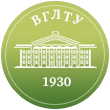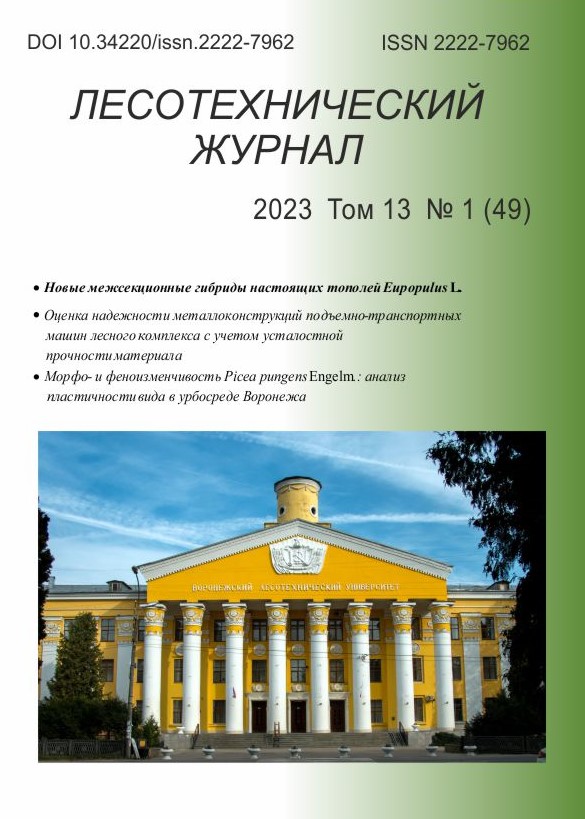с 01.01.2021 по настоящее время
ФГБОУ ВО «Воронежский государственный лесотехнический университет имени Г. Ф. Морозова», ул. Тимирязева, 8, г. Воронеж, 394087, Россия
Россия
Воронеж, Воронежская область, Россия
Россия
УДК 630 Лесное хозяйство. Лесоводство
ГРНТИ 66.03 Древесиноведение
ГРНТИ 66.29 Технология и оборудование для обработки древесины
Предложен способ аппроксимации внутреннего трения древесины на основе принципа суперпозиции Больцмана, описывающего сложное вязкоупругое поведение системы линейной комбинацией компонентов. На подготовленные образцы натуральной и модифицированной древесины, выпиленные из стволовой части деревьев березы повислой (Betula pendula Roth), произраставших в Хлевенском Лесхозе (52.184130, 39.110463, НУМ 157м), воздействовали в радиальном и тангенциальном направлениях ультразвуком (частота 24.5 кГц, экспозиция 0-20 минут, шаг 5 минут) и импульсным магнитным полем (напряженность – 0.3 Тл, экспозиция 0-2 минуты, шаг 0.5 минуты). Далее исследовали внутреннее трение образцов на экспериментальной установке методом логарифмического декремента затухания на основе свободно-изгибных колебаний. Получены при уровне значимости p=0.95 абсолютные величины безразмерного коэффициента вязкости κ, заложенного в модели, как основного структурного параметра для образцов натуральной и модифицированной древесины: для влажности от 4.3 до 15; для ультразвука 4.6 до 20; для импульсного магнитного поля от 3.6 до 7.7. Абсолютные величины безразмерных коэффициентов масштабирования μ для образцов из натуральной и модифицированной древесины принимают значение от 1.92 до 3.91. Наибольшая величина аппроксимации была достигнута при испытании образцов натуральной древесины березы повислой (Betula pendula Roth): R2=0.98 для радиального направления, влияние фактора влажности, и R2=0.85 – для тангенциального, влияние фактора ультразвука, а также для образца из модифицированной древесины марки «Дестам» в радиальном направлении R2=0.96, влияние фактора импульсного магнитного поля.
внутреннее трение древесины, натуральная и модифицированная древесина, береза повислая (Betula pen-dula Roth), принцип суперпозиции Больцмана, модифицирование, ультразвук, магнитное поле
1. Cai C., Zhou F. Sorption characteristic of thermally modified wood at varying relative humidity. Forests. 2022; 13(10):1687.DOI:https://doi.org/10.3390/f13101687 EDN: https://elibrary.ru/RNQRAC
2. Ali M. R., Abdullah U. H. Hydrothermal modification of wood: A review. Polymers.2021; 13(16): 2612. DOI: https://doi.org/10.3390/polym13162612.
3. Romano A., Cappellin L. Exploring volatile organic compound emission from thermally modified wood by PTR-ToF-MS. Analyst. 2022;147 (22): 5138-5148. DOI: http://dx.doi.org/10.1039/D2AN01376B EDN: https://elibrary.ru/XBABTN
4. Wang Y., Zhang R. Improvement on dimensional stability and mold resistance of wood modified by tannin acid and tung oil.Holzforschung. 2022; 76 (10): 929-940. DOI: https://doi.org/10.1515/hf-2022-0062 EDN: https://elibrary.ru/DAEFQB
5. Hu J. Manufacturing and characterization of modified wood with in situ polymerization and Cross-Linking of Water-Soluble Monomers on Wood Cell Walls. Polymers. 2022; 14(16):3299. DOI: https://doi.org/10.3390/polym14163299 EDN: https://elibrary.ru/FVZCDV
6. Bytner O., Laskowska A. Evaluation of the dimensional stability of black poplar wood modified thermally in nitrogen atmosphere. Materials. 2021; 14(6): 1491. DOI: http://dx.doi.org/10.3390/ma14061491 EDN: https://elibrary.ru/ZWQQSG
7. Shukla S. R. Evaluation of dimensional stability, surface roughness, colour, flexural properties and decay resistance of thermally modified Acacia auriculiformis.MaderasCiencia y Tecnologia. 2019; 21(4): 433-446. DOI: http://dx.doi.org/10.4067/S0718-221X2019005000401
8. Youming D., Silong G. The effect mechanism and properties of poplar wood cross-linking modified with polyols and polycarboxylic acid. Wood Material Science & Engineering. 2023; 1(18): 1-11. DOI: http://dx.doi.org/10.1080/17480272.2023.2167110
9. Mohebby B., Broushakian V. Moisture induced stresses in cross laminated timber (CLT) made from hydrothermally modified wood. Eur.J.WoodProd. 2022; 80: 1087-1094. DOI: https://doi.org/10.1007/s00107-022-01836-0 EDN: https://elibrary.ru/DKJSVW
10. Thais M.B., Glaucileide F. Resistance to biodeterioration of thermally modified Eucalyptus grandis and Tectonagrandis short-rotation wood. Wood Material Science & Engineering. 2022; 11 (26): 1-8. DOI: http://dx.doi.org/10.1080/17480272.2022.2150985
11. Plaza N.Z.,Pingali S.V., Ibach R.E. Nanostructuralchanges correlated to decay resistance of chemically modified wood fibers. Fibers. 2022; 10(5):40. DOI: https://doi.org/10.3390/fib10050040 EDN: https://elibrary.ru/QHROXS
12. Kurkowiak K., Wu M., Emmerich L. Fire-retardant properties of wood modified with sorbitol, citric acid and a phosphorous-based system. Holzforschung.2023; 77(1): 38-44. DOI: https://doi.org/10.1515/hf-2022-0114 EDN: https://elibrary.ru/OFKGWO
13. Sikora A., Hajkova K., Jurczykova T. Degradation of chemical components of thermally modified robiniapseudoacacia L. wood and Its effect on the change in mechanical properties. International Journal of Molecular Sciences. 2022; 23(24):15652. DOI: https://doi.org/10.3390/ijms232415652 EDN: https://elibrary.ru/FLKAQI
14. Nisrina P.H., Resa M., Istie S.R. Surface characterization and paint bonding quality on chemically and thermally modified short rotation teak wood. International Wood Products Journal. 2022; 11 (8): 1-8. DOI: http://dx.doi.org/10.1080/20426445.2022.2138908 EDN: https://elibrary.ru/HACRZO
15. Cambazoglu M., Tomak E.D., Ermeydan M.A. Natural weathering of spruce wood chemically modified by reused-caprolactone solution. Coloration Technology. 2022; 10 (4): 17-28. DOI https://doi.org/10.1111/cote.12645 EDN: https://elibrary.ru/NDOWYL
16. Miklecic J., Loncaric A., Veselicic N.,Jirous-Rajkovic V. Influence of wood surface preparation on roughness, wettability and coating adhesion of unmodified and thermally modified wood. Drvnaindustrija.2022; 73 (3): 261-269. DOI: https://doi.org/10.5552/drvind.2022.0016 EDN: https://elibrary.ru/NIQUMB
17. Juncheng L., Wei W., Haolin W. Prediction of thermal modified wood color change after artificial weathering based on IPSO-SVM model.Research Square.2022; 11: 1-17. DOI: http://dx.doi.org/10.21203/rs.3.rs-2327397/v1
18. Kymalainen M., Domeny J., Rautkari L. Moisture sorption of wood surfaces modified by one-sided carbonization as an alternative to traditional facade coatings. Coatings. 2022; 12(9):1273. DOI: https://doi.org/10.3390/coatings12091273 EDN: https://elibrary.ru/FKRHJM
19. Buchelt B., Kruger R.,Wagenfuhr, A. The vibrational properties of native and thermally modified wood in dependence on its moisture content. Eur. J. Wood Prod. (2023); 1(13): 1-8. DOI: https://doi.org/10.1007/s00107-022-01919-y EDN: https://elibrary.ru/JGJLRD
20. Chen X., Ge-Zhang S., Han Y. Ultraviolet-assisted modified delignified wood with high transparency. Applied Sciences. 2022; 12(15):7406. DOI: https://doi.org/10.3390/app12157406 EDN: https://elibrary.ru/SRARCD
21. Liu Y., Avramidis S. Air permeability of thermally modified hemlock wood. Les/Wood.2022; 71(2): 25-30. DOI: https://doi.org/10.26614/les-wood.2022.v71n02a01 EDN: https://elibrary.ru/ALYMIQ
22. Tomov G. Reduction of Electricity Consumption in the Production of Thermally Modified Wood. 2022 22nd International Symposium on Electrical Apparatus and Technologies (SIELA), Bourgas, Bulgaria. 2022;1:1-6.DOI: http://dx.doi.org/10.1109/SIELA54794.2022.9845726
23. Bonfatti Junior E.A., Lengowski E.C., Nisgoski S. Properties of thermally modified woods by a Brazilian process. Environmental Sciences Proceedings. 2022; 22(1):24. DOI: https://doi.org/10.3390/IECF2022-13042
24. Aytin A., Cakicier, N. Weathering’s effect on color and roughness in some heat-treated wood species with modified water-based varnish. BioResources.(2022); 17(4): 6358-6376. DOI: http://dx.doi.org/10.15376/biores.17.4.6358-6376 EDN: https://elibrary.ru/LNWHJJ
25. Roberts G., Campbell S., Graham A. The environmental and social impacts of modified wood production: effect of timber sourcing. International Wood Products Journal. 2022; 13(4): 236-254. DOI: http://dx.doi.org/10.1080/20426445.2022.2117923 EDN: https://elibrary.ru/IYSNSZ
26. Mamonova M., Ciglian D., Reinprecht L. SEM analysis of glued joints of thermally modified wood bonded with PUR and PVAc. Glues Materials. 2022; 15(18):6440. DOI: https://doi.org/10.3390/ma15186440 EDN: https://elibrary.ru/TBMNRK
27. Chen Y., Wang W., Li N. Prediction of the equilibrium moisture content and specific gravity of thermally modified wood via an Aquila optimization algorithm back-propagation neural network model.BioResources. 2022; 17(3): 4816-4836. DOI: http://dx.doi.org/10.15376/biores.17.3.4816-4836 DOI:https://doi.org/10.15376/biores.17.3.4816-4836 EDN: https://elibrary.ru/CTYGPF
28. Haftkhani A.R., Abdoli F., Rashidijouybari I. Prediction of water absorption and swelling of thermally modified fir wood by artificial neural network models. Eur. J. Wood Prod. 2022; 80: 1135-1150. DOI: https://doi.org/10.1007/s00107-022-01839-x EDN: https://elibrary.ru/KZYXRO
29. Nasir V., Nourian S., Avramidis S., Cool J. Stress wave evaluation for predicting the properties of thermally modified wood using neuro-fuzzy and neural network modeling. Holzforschung. 2019; 73(9), 827-838. DOI: http://dx.doi.org/10.1515/hf-2018-0289 EDN: https://elibrary.ru/ZRDKUU
30. Golovin, I. S., Cordero, F. Internal Friction and Mechanical Spectroscopy (IFMS-19). Concluding Remarks. Journal of Alloys and Compounds. 2023; 946, 169375. DOI: https://doi.org/10.1016/j.jallcom.2023.169375.
31. Патент № 2712521 C1 Российская Федерация, МПК B27K 5/06. Способ получения модифицированной древесины : № 2019103517 : заявл. 07.02.2019 :опубл. 29.01.2020 / В. А. Шамаев, И. Н. Медведев, Д. А. Паринов, О. Ф. Шишлов ; заявитель и патентообладатель Общество с ограниченной ответственностью "Модификация" - 8 с. Режим доступа: https://www.elibrary.ru/item.asp?id=42449800












